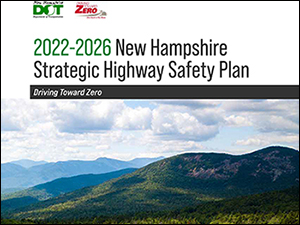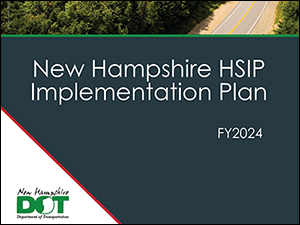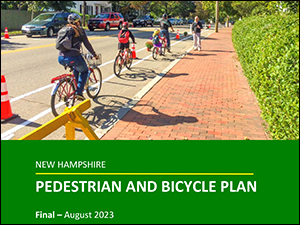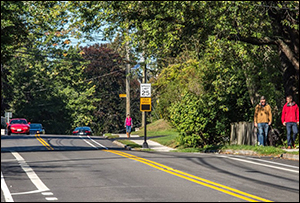Highway Safety Improvement Program (HSIP)
The overall purpose of the Highway Safety Improvement Programs is to achieve a significant reduction in fatalities and serious injuries on all public roads through the implementation of highway safety improvement projects. This includes infrastructure-related projects, selected and justified by proven data-driven approaches. All highway safety improvement projects should be chosen and implemented with the goal of reducing fatalities and serious injuries on public roads.
The information below is intended to answer some common questions and provide additional information to communities and the general public for the Highway Safety Improvement Program.
NH Guidance Information
Road Safety Audit (RSA)
NH Safety Plans and Assessments
- Strategic Highway Safety Plan
- HSIP Implementation Plan
- NH Pedestrian and Bike Plan
- Vulnerable Road User Safety Assessment

The Strategic Highway Safety Plan (SHSP) is intended as a tool to help identify safety concerns (primarily using the Critical Emphasis Areas noted below) along New Hampshire roads to select and implement appropriate countermeasure to reduce crashes. This is performed in collaboration with private and public stakeholders in a variety of fields, including education, enforcement, engineering, emergency medical services, and others.
Strategic Highway Safety Plan 2022-2026
Strategic Highway Safety Plan 2017-2021
Strategic Highway Safety Plan 2012-2016
Critical Emphasis Areas (CEA)
The SHSP includes Critical Emphasis Areas (CEAs) to identify ten (10) categories to focus resources towards to improve the safety of New Hampshire’s transportation network. These CEAs are:
- Intersections
- Roadway Departure
- Distracted Driving
- Impaired Driving
- Speed and Aggressive Driving
- Vehicle Occupant Protection
- Older Drivers
- Teen Traffic Safety
- Vulnerable Roadway Users – Motorized
- Vulnerable Roadway Users – Non-Motorized
Each of the CEAs include the following information to assist in addressing these categories:
- Definition – Define the CEA
- Call to Action – Context for inclusion of the CEA, supporting by prevailing crash types and why certain strategies and supporting actions were selected.
- Mile Maker – Presents five (5) years of fatal and serious injury data from 2015-2019*, while also identifying the top overlapping CEAs.
- Key Accomplishments – Highlights the last five (5) years of accomplishments stakeholders have made with the CEA.
- Reaching the Destination – Strategies and supporting actions to reduce fatalities and serious injuries for the CEA.
- Lead Agency – Identify the agency responsible for leading the implementation of the previously discussed strategies and supporting actions.
- Timeline – An estimation of the time to implement each strategy or supporting action.
*This was the latest complete set of five (5) year data when this iteration of the SHSP was developed.

As part of Federal Highway Administration (FHWA) requirements, every state is mandated to annually analyze the following five (5) safety performance measures:
- Number of Fatalities
- Rate of Fatalities per 100 Million Vehicle Miles Traveled (HMVMT)
- Number of Serious Injuries
- Rate of Serious Injuries per HMVMT
- Number of Non-Motorized Fatalities and Serious Injuries
To accomplish this, each state evaluates the most recent five (5) years of measured data to predict five (5) year average trends and set safety performance targets for the upcoming year for each performance measure. The state is required to meet or make significant progress towards these safety performance targets in at least four (4) of the five (5) performance measures (23 CFR 924); otherwise the State is required to develop a Highway Safety Improvement Program (HSIP) Implementation Plan for the next year. Target setting for each of the performance measures occurs on an annual basis regardless.
The HSIP Implementation Plan identifies and discusses the following elements:
- Features that constitute a hazard to road users.
- Safety improvement projects based on crash experience, crash potential, or other data-supported means.
- How HSIP funds will be allocated to support projects, activities, and strategies.
- How proposed projects, activities, and strategies funded through HSIP will allow the State to make progress in achieving safety performance targets.
- Actions the State will undertake to achieve the performance targets.

The New Hampshire Pedestrian and Bicycle Plan serves as a roadmap for the future of active transportation on and across state roadways in New Hampshire.
Pedestrian and Bicycle Plan 2023
The Plan is envisioned to influence NH’s active transportation decisions for the next ten (10) years by guiding infrastructure recommendations and promoting changes in planning practices by focusing on three overarching goals:
- Goal 1: Safety
- Reduce the number of fatal and serious injury crashes involving pedestrians and bicycles.
- Create context sensitive solutions with policies, programs, and facilities to increase pedestrian and bicyclist safety.
- Goal 2: Access
- Address gaps in pedestrian and bicycle networks to connect key destinations, regions, and communities.
- Increase accessibility to low-stress facilities.
- Goal 3: Culture
- Create a “culture of safety” by prioritizing the needs of all users in roadway planning, design, and maintenance, as well as public facing NHDOT communications.
- Expand Complete Streets principles into everyday practice.
This Plan provides action items identified to take next steps towards accomplishing these goals, and can be applied to one or more of the following:
- Provide an analysis of existing conditions and develop network recommendations.
- Provide an inventory of existing Level of Stress conditions.
- Provide a summary and recommended changes or revisions of the current policies and practices.
- Inform planning, scoping, design, construction, and maintenance phases of projects.
- Provide direction to Regional Planning Commissions.
- Identify potential projects.
- Direct future planning efforts, programs, policies, and transportation project development.
Other helpful links:
Bikes and Pedestrians

The Vulnerable Road User (VRU) Safety Assessment is aimed at addressing the safety of pedestrians and bicyclists on New Hampshire’s roads. This Safety Assessment is a mandated effort as part of NH’s Highway Safety Improvement Program and aims to address the rising number of fatal and serious crashes involving pedestrians and bicyclists through a data-driven analysis to identify high-risk areas and vulnerable populations.
Vulnerable Road User Safety Assessment 2023
The VRU Safety Assessment includes applicable countermeasures included in FHWA's 28 Proven Safety Countermeasures appropriate for enhancing pedestrian and bicyclist safety, including but not limited to:
- Sidewalks/Walkways
- Bike Facilities
- Crosswalk Visibility Enhancements
- Medians and Pedestrian Refuge Islands
- Rectangular Rapid Flashing Beacons (RRFBs)
- Leading Pedestrian Interval
- Pedestrian Hybrid Beacon
- Road Diets
- Speed Management
- Street Lighting
The VRU Safety Assessment also provides several strategies and recommendations to facilitate the effort to achieve a safer environment for pedestrians and bicyclists, including infrastructure improvement, educational opportunities, and planning/research efforts:
- Strategy 01: Enhance Bike and Pedestrian Safety Identified within the High Injury Network
- Strategy 02: Identify, Adopt, and Encourage the Use of Best Practices
- Strategy 03: Develop a Series of Programs Intended to Provide Technical Assistance to Local Entities
- Strategy 04: Educate State Employees, External Partners, and the Public about Needs of Vulnerable Road Users
- Strategy 05: Improve Data Collection and Analysis
- Strategy 06: Invest in Pedestrian and Bicycle Safety
*Transcripts and recordings of the Stakeholder meetings are available upon request
Additional Website Links:



